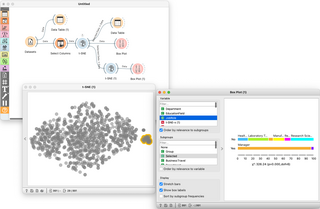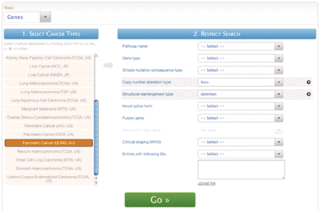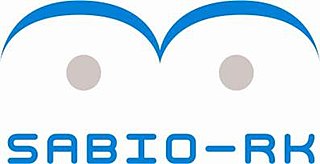
Bioinformatics is an interdisciplinary field of science that develops methods and software tools for understanding biological data, especially when the data sets are large and complex. Bioinformatics uses biology, chemistry, physics, computer science, computer programming, information engineering, mathematics and statistics to analyze and interpret biological data. The subsequent process of analyzing and interpreting data is referred to as computational biology.

Orange is an open-source data visualization, machine learning and data mining toolkit. It features a visual programming front-end for explorative qualitative data analysis and interactive data visualization.

Carole Anne Goble, is a British academic who is Professor of Computer Science at the University of Manchester. She is principal investigator (PI) of the myGrid, BioCatalogue and myExperiment projects and co-leads the Information Management Group (IMG) with Norman Paton.
The myGrid consortium produces and uses a suite of tools design to “help e-Scientists get on with science and get on with scientists”. The tools support the creation of e-laboratories and have been used in domains as diverse as systems biology, social science, music, astronomy, multimedia and chemistry.

Apache Taverna was an open source software tool for designing and executing workflows, initially created by the myGrid project under the name Taverna Workbench, then a project under the Apache incubator. Taverna allowed users to integrate many different software components, including WSDL SOAP or REST Web services, such as those provided by the National Center for Biotechnology Information, the European Bioinformatics Institute, the DNA Databank of Japan (DDBJ), SoapLab, BioMOBY and EMBOSS. The set of available services was not finite and users could import new service descriptions into the Taverna Workbench.

Galaxy is a scientific workflow, data integration, and data and analysis persistence and publishing platform that aims to make computational biology accessible to research scientists that do not have computer programming or systems administration experience. Although it was initially developed for genomics research, it is largely domain agnostic and is now used as a general bioinformatics workflow management system.
Kepler is a free software system for designing, executing, reusing, evolving, archiving, and sharing scientific workflows. Kepler's facilities provide process and data monitoring, provenance information, and high-speed data movement. Workflows in general, and scientific workflows in particular, are directed graphs where the nodes represent discrete computational components, and the edges represent paths along which data and results can flow between components. In Kepler, the nodes are called 'Actors' and the edges are called 'channels'. Kepler includes a graphical user interface for composing workflows in a desktop environment, a runtime engine for executing workflows within the GUI and independently from a command-line, and a distributed computing option that allows workflow tasks to be distributed among compute nodes in a computer cluster or computing grid. The Kepler system principally targets the use of a workflow metaphor for organizing computational tasks that are directed towards particular scientific analysis and modeling goals. Thus, Kepler scientific workflows generally model the flow of data from one step to another in a series of computations that achieve some scientific goal.

UGENE is computer software for bioinformatics. It works on personal computer operating systems such as Windows, macOS, or Linux. It is released as free and open-source software, under a GNU General Public License (GPL) version 2.

Fiji is an open source image processing package based on ImageJ2.
myExperiment is a social web site for researchers sharing research objects such as scientific workflows.
Discovery Net is one of the earliest examples of a scientific workflow system allowing users to coordinate the execution of remote services based on Web service and Grid Services standards. The system was designed and implemented at Imperial College London as part of the Discovery Net pilot project funded by the UK e-Science Programme. Many of the concepts pioneered by Discovery Net have been later incorporated into a variety of other scientific workflow systems.
A scientific workflow system is a specialized form of a workflow management system designed specifically to compose and execute a series of computational or data manipulation steps, or workflow, in a scientific application.

Anduril is an open source component-based workflow framework for scientific data analysis developed at the Systems Biology Laboratory, University of Helsinki.

BioMart is a community-driven project to provide a single point of access to distributed research data. The BioMart project contributes open source software and data services to the international scientific community. Although the BioMart software is primarily used by the biomedical research community, it is designed in such a way that any type of data can be incorporated into the BioMart framework. The BioMart project originated at the European Bioinformatics Institute as a data management solution for the Human Genome Project. Since then, BioMart has grown to become a multi-institute collaboration involving various database projects on five continents.

SABIO-RK is a web-accessible database storing information about biochemical reactions and their kinetic properties.
GenomeSpace is an environment for genomics software tools and applications. It helps users manage their analysis workflows involving multiple diverse tools, including web applications and desktop tools and facilitates the transfer of data between tools via automatic format conversion. Analyses can use data from local or cloud-based stores.

The OnlineHPC was a free public web service that supplied tools to deal with high performance computers and online workflow editor. OnlineHPC allowed users to design and execute workflows using the online workflow designer and to work with high performance computers – clusters and clouds. Access to high performance resources was available as directly from the service user interface, as from workflow components. The workflow engine of the OnlineHPC service was Taverna as traditionally used for scientific workflow execution in such domains, as bioinformatics, cheminformatics, medicine, astronomy, social science, music, and digital preservation.

The Common Workflow Language (CWL) is a standard for describing computational data-analysis workflows. Development of CWL is focused particularly on serving the data-intensive sciences, such as Bioinformatics, Medical Imaging, Astronomy, Physics, and Chemistry. A key goal of the CWL is to allow the creation of a workflow that is portable and thus may be run reproducibly in different computational environments.
The 'German Network for Bioinformatics Infrastructure – de.NBI' is a national, academic and non-profit infrastructure initiated by the Federal Ministry of Education and Research funding 2015-2021. The network provides bioinformatics services to users in life sciences research and biomedicine in Germany and Europe. The partners organize training events, courses and summer schools on tools, standards and compute services provided by de.NBI to assist researchers to more effectively exploit their data. From 2022, the network will be integrated into Forschungszentrum Jülich.
Nextflow is a scientific workflow system predominantly used for bioinformatic data analyses. It imposes standards on how to programmatically author a sequence of dependent compute steps and enables their execution on various local and cloud resources. Nextflow was conceived at the Centre for Genomic Regulation in Barcelona, Spain, but has since found world-wide adoption in biomedical and genomics research facilities and laboratories.











